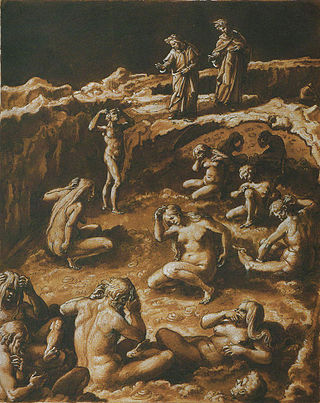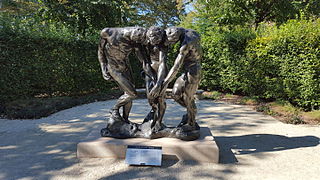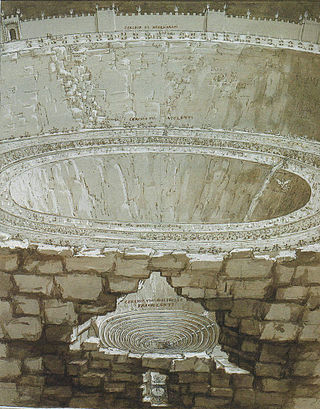
Dante Alighieri, most likely baptized Durante di Alighiero degli Alighieri and often referred to as Dante, was an Italian poet, writer, and philosopher. His Divine Comedy, originally called Comedìa and later christened Divina by Giovanni Boccaccio, is widely considered one of the most important poems of the Middle Ages and the greatest literary work in the Italian language.

Brunetto Latini was an Italian philosopher, scholar, notary, politician and statesman.

In Dante Alighieri's Inferno, part of the Divine Comedy, Malebolge or Fraud is the eighth circle of Hell. Roughly translated from Italian, Malebolge means "evil ditches". Malebolge is a large, funnel-shaped cavern, itself divided into ten concentric circular trenches or ditches. Each trench is called a bolgia. Long causeway bridges run from the outer circumference of Malebolge to its center, pictured as spokes on a wheel. At the center of Malebolge is the ninth and final circle of hell, known as Cocytus.

"Rappaccini's Daughter" is a Gothic short story by Nathaniel Hawthorne first published in the December 1844 issue of The United States Magazine and Democratic Review in New York, and later in various collections. It is about Giacomo Rappaccini, a medical researcher in Padua who grows a garden of poisonous plants. He brings up his daughter to tend the plants, and she becomes resistant to the poisons, but in the process she herself becomes poisonous to others. The traditional story of a poisonous maiden has been traced back to India, and Hawthorne's version has been adopted in contemporary works.

The Scrovegni Chapel, also known as the Arena Chapel, is a small church, adjacent to the Augustinian monastery, the Monastero degli Eremitani in Padua, region of Veneto, Italy. The chapel and monastery are now part of the complex of the Musei Civici di Padova.

Iacopo Rusticucci was a Guelph politician and accomplished orator who lived and worked in Florence, Italy in the 13th century. Rusticucci is realized historically primarily in relation to the Adimari family, who wielded much power and prestige in thirteenth-century Florence, and to whom it is thought Rusticucci was a close companion, representative, and perhaps lawyer. Despite his association with men born into high political and social rank, Rusticucci was not born into nobility, and nothing is known of his ancestors or predecessors. The exact dates of his birth and death are unknown.

In Dante Alighieri's The Divine Comedy, the City of Dis encompasses the sixth through the ninth circles of Hell.
Cunizza da Romano was an Italian noblewoman and a member of the da Romano dynasty, one of the most prominent families in northeastern Italy, Cunizza's marriages and liaisons, most notably with troubadour Sordello da Goito, are widely documented. Cunizza also appears as a character in a number of works of literature, such as Dante Alighieri's Divine Comedy.

In Dante's Inferno, Satan is portrayed as a giant demon, frozen up to the waist in ice at the center of Hell. Satan has three faces and a pair of bat-like wings affixed under each chin. As Satan beats his wings, he creates a cold wind that continues to freeze the ice surrounding him and the other sinners in the Ninth Circle. The winds he creates are felt throughout the other circles of Hell. In his three mouths, he chews on Judas Iscariot, Marcus Junius Brutus and Gaius Cassius Longinus. Scholars consider Satan to be "a once splendid being from whom all personality has now drained away". Satan, also known as Lucifer, was formerly the Angel of Light and once tried to usurp the power of God. As punishment, God banished Satan out of Heaven to an eternity in Hell as the ultimate sinner. Dante illustrates a less powerful Satan than most standard depictions; he is slobbering, wordless, and receives the same punishments in Hell as the rest of the sinners. In the text, Dante vividly illustrates Satan's grotesque physical attributes.

Enrico Scrovegni was a Paduan money-lender who lived around the time of Giotto and Dante. He was the son of Reginaldo degli Scrovegni and Capellina Malacapelli, and was married twice, first to a member of the Carrara family, then to Jacopina (Giacomina) d'Este, daughter of Francesco d'Este, Marquis of Ferrara. He may have been a member of the Cavalieri Gaudenti.

Castello di Rosso Gianfigliazzi was a Florentine nobleman who lived in the late 13th century around the time of Giotto and Dante. He is best known for being a wicked usurer according to Dante in the Divine Comedy. He practiced usury in France and was made a knight upon his return to Florence.
Ciappo Ubriachi was a Florentine nobleman who lived in the late 13th century around the time of Giotto and Dante. In the Florentine Guelph-Ghibelline conflict, his family was a Ghibelline. He is best known for being a wicked usurer according to Dante in the Divine Comedy.
Vitaliano di Iacopo Vitaliani was a Paduan nobleman who lived in the late 13th century around the time of Giotto and Dante. He is best known for being a wicked usurer according to Dante in the Divine Comedy.
Giovanni di Buiamonte was a Florentine nobleman who lived in the late 13th century around the time of Giotto and Dante. He was highly esteemed in the Florence of his day as “the sovereign cavalier", and was chosen for many high offices.

The Wood of the Self-Murderers: The Harpies and the Suicides is a pencil, ink and watercolour on paper artwork by the English poet, painter and printmaker William Blake (1757–1827). It was completed between 1824 and 1827 and illustrates a passage from the Inferno of the Divine Comedy by Dante Alighieri (1265–1321).

Inferno is the first part of Italian writer Dante Alighieri's 14th-century narrative poem The Divine Comedy. It is followed by Purgatorio and Paradiso. The Inferno describes the journey of a fictionalised version of Dante himself through Hell, guided by the ancient Roman poet Virgil. In the poem, Hell is depicted as nine concentric circles of torment located within the Earth; it is the "realm ... of those who have rejected spiritual values by yielding to bestial appetites or violence, or by perverting their human intellect to fraud or malice against their fellowmen". As an allegory, the Divine Comedy represents the journey of the soul toward God, with the Inferno describing the recognition and rejection of sin.

Paradiso is the third and final part of Dante's Divine Comedy, following the Inferno and the Purgatorio. It is an allegory telling of Dante's journey through Heaven, guided by Beatrice, who symbolises theology. In the poem, Paradise is depicted as a series of concentric spheres surrounding the Earth, consisting of the Moon, Mercury, Venus, the Sun, Mars, Jupiter, Saturn, the Fixed Stars, the Primum Mobile and finally, the Empyrean. It was written in the early 14th century. Allegorically, the poem represents the soul's ascent to God.

The first circle of hell is depicted in Dante Alighieri's 14th-century poem Inferno, the first part of the Divine Comedy. Inferno tells the story of Dante's journey through a vision of hell ordered into nine circles corresponding to classifications of sin. The first circle is Limbo, the space reserved for those souls who died before baptism and for those who hail from non-Christian cultures. They live eternally in a castle set on a verdant landscape, but forever removed from heaven.

The second circle of hell is depicted in Dante Alighieri's 14th-century poem Inferno, the first part of the Divine Comedy. Inferno tells the story of Dante's journey through a vision of the Christian hell ordered into nine circles corresponding to classifications of sin; the second circle represents the sin of lust, where the lustful are punished by being buffeted within an endless tempest.

The third circle of hell is depicted in Dante Alighieri's Inferno, the first part of the 14th-century poem Divine Comedy. Inferno tells the story of Dante's journey through a vision of the Christian hell ordered into nine circles corresponding to classifications of sin; the third circle represents the sin of gluttony, where the souls of the gluttonous are punished in a realm of icy mud.














